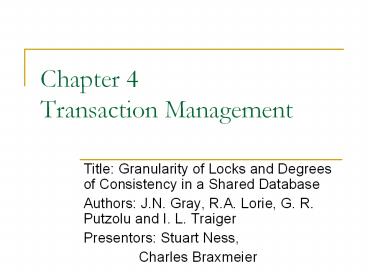Chapter 4 Transaction Management - PowerPoint PPT Presentation
1 / 12
Title:
Chapter 4 Transaction Management
Description:
Chapter 4 Transaction Management ... root to leaf Leaf nodes are never ... All Records in F implicit mode S Database Area 1 File F Index I Record R Record Q ... – PowerPoint PPT presentation
Number of Views:41
Avg rating:3.0/5.0
Title: Chapter 4 Transaction Management
1
Chapter 4 Transaction Management
- Title Granularity of Locks and Degrees of
Consistency in a Shared Database - Authors J.N. Gray, R.A. Lorie, G. R. Putzolu and
I. L. Traiger - Presentors Stuart Ness,
- Charles Braxmeier
2
Outline
- Motivation
- Problem Definition
- Contributions
- Key Concepts
- Validation Methodology
- Assumptions
- Rewrite Changes
3
Motivation
- Concurrent Transactions
- Existing Locking mechanisms
- Overhead
- large-granularity locking
- Alternatives to existing techniques
- Finer-granularity
- Less overhead
4
Problem Definition
- Given
- Shared Database
- Need for Concurrent Processing
- Find Efficient DBMS Lock method
- Inherent Locking mechanism
- Fine Granularity locks
- Objectives
- Efficiency
- Low Overhead
- Constraints
- Hierarchical Database Systems
5
Contributions
- Produces a technique for the implicit locking of
an entire sub-tree - Introduce an intention mode to tag ancestors to
prevent explicit or implicit exclusive or share
modes (allows for implicit locking) - Implements a method that allows for fine
granularity without drastically increasing
overhead (implicit locking)
6
(No Transcript)
7
(No Transcript)
8
(No Transcript)
9
Concepts
- Dynamic Locks
- Index interval locks index based on value
- Extends DAG adding a lock on the index intervals.
(If moving from one index interval to another, it
requires both) - Scheduling and Granting Requests
- Coexisting requests per group
- Conversion modes
- Request higher permissions
- Deadlock due to higher permission requests
10
Validation Methodology
- Content primarily presents informal theory
- Validated while being developed and implemented
on IBM Research Lab System - Shows benefits of working system / Proof of
concept - Authors have used the IMS/VS system
- Lacks formal proof
11
Assumptions
- Database can be broken into some fashion of a
hierarchical form - Assumes the use of an early database model
(hierarchical or directed graph in nature). - This assumption does not allow for transcending
to all DB types without additional effort
(relational and structured, etc) - Removing assumption allows for maintaining a
basic structure, but would require other means of
controlling the concurrency access. - Possible problems with more complex index based
queries
12
Rewrite Changes
- Rewrite to reflect the current state of database
systems (as article is from 1975) - Add statistical evidence of tradeoffs between
overhead and concurrency - Preserve the notion of intention modes and the
scheduling of blocking non-compatible modes.








![Measuring and Managing Translation and Transaction Exposure [Shapiro: Chapter 10] PowerPoint PPT Presentation](https://s3.amazonaws.com/images.powershow.com/A1256656656cXWvx.th0.jpg?_=20140117087)






















